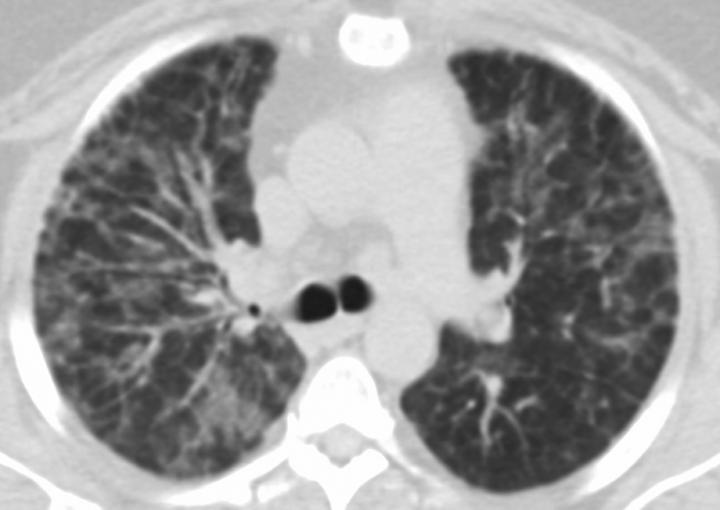AJR details patterns of inhalation lung injury associated with vaporizers and e-cigarettes: hypersensitivity pneumonitis, diffuse alveolar hemorrhage, acute eosinophilic pneumonia, organizing pneumonia, lipoid pneumonia, giant cell interstitial pneumonia

Credit: American Journal of Roentgenology (AJR)
Leesburg, VA, October 9, 2019–An ahead-of-print “Clinical Perspective” article in the March issue of the American Journal of Roentgenology (AJR) summarizing the literature to date details common imaging manifestations of electronic nicotine delivery systems (ENDS)–including e-cigarettes and vaporizers, vape and hookah pens, as well as tank systems.
Because there is not a “standardized case definition for vaping-associated lung injury,” wrote lead author Travis S. Henry from the University of California San Francisco, “the diagnosis of lung injury due to vaping may be made by establishing a temporal relationship between change in vaping habits and onset of lung disease, exclusion of other causes of lung disease (e.g., infection, other drug or exposure, connective tissue disease, and so on), and stabilization or improvement with cessation of vaping and possibly with corticosteroid treatment.”
Stressing the importance of recognizing the following patterns seen with ENDS, Henry et al. note that the radiologist may be the first person to prompt the clinical team to ask about relevant exposures:
Hypersensitivity Pneumonitis
Typical findings on CT include symmetric upper lung-predominant and midlung-predominant ground-glass opacity (GGO), poorly defined centrilobular nodules, and occasionally mosaic attenuation reflective of air trapping. Henry and team observed improvement after cessation of antigen inhalation.
Diffuse Alveolar Hemorrhage
Although chest radiography or CT alone is not sufficient to distinguish from other causes of acute lung opacities–aspiration, edema, infection, etc.–patients may be anemic, and bronchoalveolar lavage (BAL) with persistent or increasingly bloody aliquots can confirm diagnosis.
Acute Eosinophilic Pneumonia
Often secondary to first-time vape usage, use increase, brand change, or resumption of traditional smoking products, recent cases have been difficult to diagnosis due to nonspecific manifestations and the absence of peripheral eosinophilia at the time of presentation.
Organizing Pneumonia
A common response to lung injury characterized by fibroblast proliferation and collagen deposition, the most typical CT findings are bilateral patchy GGO, consolidation, or both in peripheral or perilobular distribution. Henry and colleagues noted that the “reverse halo” or “atoll” sign is also associated with organizing pneumonia.
Lipoid Pneumonia
Although the basic content of ENDS flavoring agents are juices, agent constituents like glycerin may produce in the form of endogenous phospholipidosis. However, macroscopic fat attenuation within consolidation (
Giant Cell Interstitial Pneumonia
With hard metal contamination of vaping aerosols well documented, Henry et al. encountered one pathologically proven case of this rare pneumoconiosis, attributable to trace amounts of cobalt in the patient’s vape pen.
“Because of the heterogeneity of both the construction of e-cigarettes and the substances aerosolized, there are likely many other pulmonary manifestations not covered in this article,” Henry acknowledged.
For instance, ENDS mixtures may also contain compounds such as diacetyl, “known to cause other lung injury patterns, including constrictive bronchiolitis,” he concluded.
###
Founded in 1900, the American Roentgen Ray Society (ARRS) is the first and oldest radiology society in the North America, dedicated to the advancement of medicine through the profession of radiology and its allied sciences. An international forum for progress since the discovery of the x-ray, ARRS maintains its mission of improving health through a community committed to advancing knowledge and skills with an annual scientific meeting, monthly publication of the peer-reviewed American Journal of Roentgenology (AJR), quarterly issues of InPractice magazine, AJR Live Webinars and Podcasts, topical symposia, print and online educational materials, as well as awarding scholarships via The Roentgen Fund®.
Media Contact
Logan K. Young
[email protected]
703-858-4332
Original Source
https:/
Related Journal Article
http://dx.




